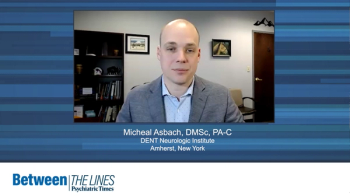
Publication Introductions and Overview of TD
Richard Jackson, MD, and Micheal Asbach, DMSc, PA-C, provide an overview of tardive dyskinesia (TD) and highlight recent studies that assessed the burden of TD on patients.
Brought to you by Teva Medical Affairs.
Richard Jackson, MD: Hello. Welcome to this Psychiatric Times™ Between the Lines video series titled Expert Insights on the Impacts of Tardive Dyskinesia on Patient Quality of Life. My name is Richard Jackson. I am an adult, child, and forensic psychiatrist associated with Oakland Beaumont University School of Medicine, Department of Psychiatry, and the University of Michigan School of Medicine, Department of Psychiatry. And joining me today is Michael Asbach. He is the Associate Director of Interventional Psychiatry at the ENT Neurological Institute in Amherst, New York. And welcome, Michael.
Micheal Asbach, DMSc, PA-C: Hi. Thank you. I'm so glad to be here. And just a little bit more about myself, I'm a psychiatric PA up in Buffalo, New York, and thankfully it's not snowing here. So, hopefully we are getting into some warmer weather.
Richard Jackson, MD: Great. Well, thank you, Michael. And let's get started. So if you could just give us some background, what is tardive dyskinesia, often referred to as TD, and why is it important to assess its impact on patients?
Micheal Asbach, DMSc, PA-C: It's such a great question and I'm so glad that we're gonna talk about TD today within the context of impact. I think this is something that clinicians really need to understand in terms of how important it is. So first, let's set the stage. Tardive dyskinesia is a hyperkinetic movement disorder, and we most commonly think of this as involuntary, repetitive movements, a lot of times of the oral facial muscles, but truly it can be trunk and extremities as well; it can be any muscle. The prevalence of TD has increased over the years, and this can be due to a variety of factors. It may be related to our population's aging, higher clinical awareness of TD, but also the increased use of antipsychotic agents. Patients with schizophrenia, bipolar disorder, and major depressive disorder are at higher risk of developing TD due to the use of these antipsychotic agents. Patients are negatively affected by TD in their daily activities, including professional and social life and even self-care. It's important for us to understand that the burden of TD is not just based on the absence or presence of movements, but rather what impact those movements may have. And as we plan with patients to find good treatment plans or find paths to improve care, we need to think about symptom management, but also, the overall quality of life for patients with TD. When we think about TD, I always like to think with my patients of what impact those movements may have. So for example, someone that has abnormal movements in their hands may struggle to button a shirt. Someone who has movements in their mouth or in their face may struggle to eat. Maybe they're biting their tongue or their cheek and this is causing them a great deal of pain or discomfort. These are the types of functional impairments that we need to think of when we're assessing our patients with TD.
Richard Jackson, MD: Great points, and I think one of the most important points that we have to look at is the majority of TD patients, unfortunately, are not even diagnosed or treated with TD. So, understanding this impact is of great importance to clinicians as it really supports the need to look for abnormal movements and the impact each time we see patients. And to highlight this, there was 2 recent publications that came out describing the impact of tardive dyskinesia on various domains of life. Can you help us understand those studies and the objectives and methods of the 2 publications?
Micheal Asbach, DMSc, PA-C: I'd love to. So, the first publication was by Dr Jain and colleagues in 2023, and it aimed to assess the physical, psychological, social, and professional impact of TD on patients in the US. The second publication was also by Jain and colleagues in 2023, but this one looked at [the] caregivers' perspective and perception of the impact of TD on patients within the same domains as the previous study. In addition, it reports that on the experiences and concerns of caregivers, including self-reported burden of caregiving tasks, psychological well-being, daily activities, and professional life. Both studies used online surveys to assess the burden of TD, and patients with TD and caregivers rated the impact of TD on physical, psychological, and social domains on a five-point scale. Patients rated the impact of TD movements on work productivity and activity impairment, and caregivers provided responses on the impact of TD-related caregiving tasks on their own psychological well-being and daily activities.
Newsletter
Receive trusted psychiatric news, expert analysis, and clinical insights — subscribe today to support your practice and your patients.


















